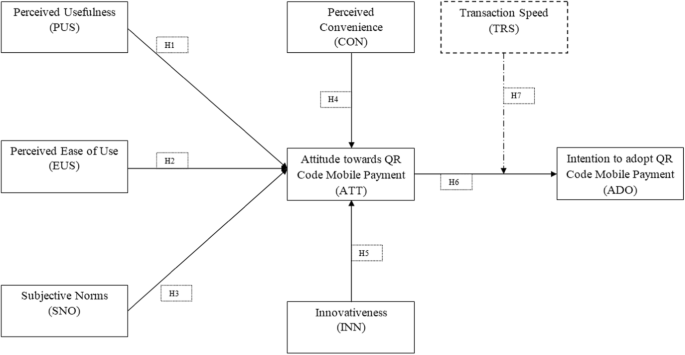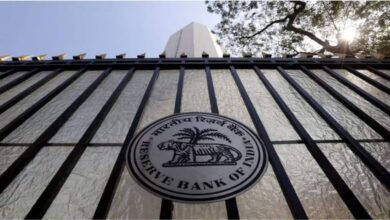Examining consumer behavior towards adoption of quick response code mobile payment systems: transforming mobile payment in the fintech industry

Ahn H, Park E (2023) Motivations for user satisfaction of mobile fitness applications: an analysis of user experience based on online review comments. Humanit Soc Sci Commun 10(1):3. https://doi.org/10.1057/s41599-022-01452-6
Ajzen I, Fishbein M (1977) Attitude-behavior relations: a theoretical analysis and review of empirical research. Psychol Bull 84(5):888
Al Nawayseh M (2020) Fintech in COVID-19 and beyond: what factors are affecting customers’ choice of fintech applications? J Open Innov Technol Mark Complex 6:153
Alamoudi H (2022) Examining retailing sustainability in the QR code-enabled mobile payments context during the COVID-19 pandemic. Int J Customer Relatsh Mark Manag (IJCRMM) 13(1):1–22
Baptista G, Oliveira T (2015) Understanding mobile banking: the unified theory of acceptance and use of technology combined with cultural moderators. Comput Hum Behav. 50:418–430
Bhat JR, AlQahtani SA, Nekovee M (2023) FinTech enablers, use cases, and role of future internet of things. J King Saud Univ-Comput Inf Sci 35(1):87–101
Boden J, Maier E, Wilken R (2020) The effect of credit card versus mobile payment on convenience and consumers’ willingness to pay. J Retail Consum Serv 52:101910
Cao TK, Dang PL, Nguyen HA (2016) Predicting consumer intention to use mobile payment services: empirical evidence from Vietnam. Int J Mark Stud 8(1):117–124
Chang V, Chen W, Xu QA, Xiong C (2021) Towards the customers’ intention to use QR codes in mobile payments. J Glob Inf Manag (JGIM) 29(6):1–21
Chen L-D (2008) A model of consumer acceptance of mobile payment. Int J Mob Commun 6(1):32–52
Chen L, Nath R (2008) Determinants of mobile payments: an empirical analysis. J Int Technol Inf Manag 17:9–21
Cowart KO, Fox GL, Wilson AE (2008) A structural look at consumer innovativeness and self‐congruence in new product purchases. Psychol Mark 25(12):1111–1130
Davis FD (1993) User acceptance of information technology: system characteristics, user perceptions and behavioral impacts. Int J Man-Mach Stud 38(3):475–487
Davis FD, Bagozzi RP, Warshaw PR (1989) User acceptance of computer technology: a comparison of two theoretical models. Manag Sci 35(8):982–1003
De Kerviler G, Demoulin NT, Zidda P (2016) Adoption of in-store mobile payment: are perceived risk and convenience the only drivers? J Retail Consum Serv 31:334–344
de Luna IR, Liébana-Cabanillas F, Sánchez-Fernández J, Munoz-Leiva F (2019) Mobile payment is not all the same: the adoption of mobile payment systems depending on the technology applied. Technol Forecast Soc Change 146:931–944
Denso W (2000) QR code features. J Barcode Tech 25(3):123–135
Flavian C, Guinaliu M, Lu Y (2020) Mobile payments adoption – introducing mindfulness to better understand consumer behavior. Int J Bank Market 38(7):1386–1401
Fornell C (1992) A national customer satisfaction barometer: The Swedish experience. J Market 56:6–21
Fornell C, Larcker DF (1981) Structural equation models with unobservable variables and measurement error: algebra and statistics. J Mark Res 18(3):382
Gold AH, Malhotra A, Segars AH (2001) Knowledge management: an organizational capabilities perspective. J Manag Inf Syst 18(1):185–214
Gutiérrez F, Abud MA, Vera F, Sánchez JA (2013, 11–13 March 2013) Application of contextual QR codes to augmented reality technologies. CONIELECOMP 2013, 23rd International Conference on Electronics, Communications and Computing
Hair JF, Wolfinbarger M, Money AH, Samouel P, Page MJ (2015). Essentials of business research methods. Taylor & Francis. https://books.google.com.pk/books?id=qvjqBgAAQBAJ
Hair Jr JF, Hult GTM, Ringle C, Sarstedt M (2016). A primer on partial least squares structural equation modeling (PLS-SEM). Sage Publications
Kaatz C (2020) Retail in my pocket–replicating and extending the construct of service quality into the mobile commerce context. J Retail Consum Serv 53:101983
Kim C, Mirusmonov M, Lee I (2010) An empirical examination of factors influencing the intention to use mobile payment. Comput Hum Behav 26(3):310–322
Kline R (2011) Principles and practice of structural equation modeling, 3rd edn. Guilford Press, New York
Liébana-Cabanillas F, Ramos de Luna I, Montoro-Ríos FJ (2015) User behaviour in QR mobile payment system: the QR Payment Acceptance Model. Technol Anal Strateg Manag 27(9):1031–1049
Liu S, Zheng D (2023) Impacts of tourists’ trust, perception and acceptance of health quick response technology on responsible pandemic travel behaviours. J Hospit Tour Technol 14(2):278–294. https://doi.org/10.1108/jhtt-11-2021-0330
Makki AM, Ozturk AB, Singh D (2016) Role of risk, self-efficacy, and innovativeness on behavioral intentions for mobile payment systems in the restaurant industry. J Foodserv Bus Res 19(5):454–473
Mi Alnaser F, Rahi S, Alghizzawi M, Ngah AH (2023) Does artificial intelligence (AI) boost digital banking user satisfaction? Integration of expectation confirmation model and antecedents of artificial intelligence enabled digital banking. Heliyon 9(8):e18930. https://doi.org/10.1016/j.heliyon.2023.e18930
Nguyen G-D, Dao T-HT (2024) Factors influencing continuance intention to use mobile banking: an extended expectation-confirmation model with moderating role of trust. Humanit Soc Sci Commun 11(1):276. https://doi.org/10.1057/s41599-024-02778-z
Nicoletti B, Nicoletti W, Weis (2017) Future of FinTech. Springer
Norton K, Hall K (2006) Contactless payment comes to cell phones. Bus Week Online 11:22–25
Ooi K-B, Tan GW-H (2016) Mobile technology acceptance model: an investigation using mobile users to explore smartphone credit card. Expert Syst Appl 59:33–46
Podsakoff PM, MacKenzie SB, Lee J-Y, Podsakoff NP (2003) Common method biases in behavioral research: a critical review of the literature and recommended remedies. J Appl Psychol 88(5):879
Rahi S (2017a) Research design and methods: a systematic review of research paradigms, sampling issues and instruments development. Int J Econ Manag Sci 6(2):1–5
Rahi S (2017b) Structural Equation Modeling Using SmartPLS. CreateSpace Independent Publishing Platform. https://books.google.com.my/books?id=XwF6tgEACAAJ
Rahi S (2018) Research design and methods. CreateSpace Independent Publishing Platform. https://books.google.com.pk/books?id=FlGktgEACAAJ
Rahi S (2022) Assessing individual behavior towards adoption of telemedicine application during COVID-19 pandemic: evidence from emerging market. Libr Hi Tech 40(2):394–420. https://doi.org/10.1108/lht-01-2021-0030
Rahi S (2023) What drives citizens to get the COVID-19 vaccine? The integration of protection motivation theory and theory of planned behavior. J Soc Market (ahead-of-print). https://doi.org/10.1108/jsocm-05-2022-0100
Rahi S, Abd Ghani M (2021) Examining internet banking user’s continuance intention through the lens of technology continuance theory and task technology fit model. Digit Policy Regul Gov 23(5):456–474. https://doi.org/10.1108/dprg-11-2020-0168
Rahi S, Abd. Ghani M (2018) The role of UTAUT, DOI, perceived technology security and game elements in Internet banking adoption. World J Sci Technol Sustain Dev 15(4):338–356. https://doi.org/10.1108/wjstsd-05-2018-0040
Rahi S, Alghizzawi M, Ngah AH (2022) Factors influence user’s intention to continue use of e-banking during COVID-19 pandemic: the nexus between self-determination and expectation confirmation model. EuroMed J Bus (ahead-of-print). https://doi.org/10.1108/emjb-12-2021-0194
Rahi S, Alghizzawi M, Ngah AH (2023) Factors influence user’s intention to continue use of e-banking during COVID-19 pandemic: the nexus between self-determination and expectation confirmation model. EuroMed J Bus 18(3):380–396. https://doi.org/10.1108/emjb-12-2021-0194
Rahi S, Alnaser FM, Abd Ghani M (2019) Designing survey research: recommendation for questionnaire development, calculating sample size and selecting research paradigms. Economic and Social Development: Book of Proceedings, Scientific Research Publishing (SCIRP), pp. 1157–1169
Rahi S, Ghani M, Ngah A (2018) A structural equation model for evaluating user’s intention to adopt Internet banking and intention to recommend technology. Accounting 4(4):139–152
Rahi S, Khan MM, Alghizzawi M (2021a) Factors influencing the adoption of telemedicine health services during COVID-19 pandemic crisis: an integrative research model. Enterp Inf Syst 15(6):769–793. https://doi.org/10.1080/17517575.2020.1850872
Rahi S, Othman Mansour MM, Alharafsheh M, Alghizzawi M (2021b) The post-adoption behavior of internet banking users through the eyes of self-determination theory and expectation confirmation model. J Enterp Inf Manag 34(6):1874–1892. https://doi.org/10.1108/jeim-04-2020-0156
Rampton J (2017) How digital wallets and mobile payments are evolving and what it means for you. Entrepreneur. Retrieved from https://www.entrepreneur.com/article/287590
Rowley J (2014) Designing and using research questionnaires. Manag Res Rev 37(3):308–330
Shang D, Wu W, Schroeder D (2023) Exploring determinants of the green smart technology product adoption from a sustainability adapted value-belief-norm perspective. J Retail Consum Serv 70:103169
Shankar A, Datta B (2018) Factors affecting mobile payment adoption intention: an Indian perspective. Glob Bus Rev 19(3_suppl):S72–S89
Shankar A, Jebarajakirthy C (2019) The influence of e-banking service quality on customer loyalty: A moderated mediation approach. Int J Bank Market 37(5):1119–1142. https://doi.org/10.1108/IJBM-03-2018-0063
Singh N, Sinha N, Liébana-Cabanillas FJ (2020a) Determining factors in the adoption and recommendation of mobile wallet services in India: analysis of the effect of innovativeness, stress to use and social influence. Int J Inf Manag 50:191–205
Singh S, Sahni MM, Kovid RK (2020b) What drives FinTech adoption? A multi-method evaluation using an adapted technology acceptance model. Manag Decis 58(8):1675–1697. https://doi.org/10.1108/md-09-2019-1318
Slade EL, Dwivedi YK, Piercy NC, Williams MD (2015) Modeling consumers’ adoption intentions of remote mobile payments in the United Kingdom: extending UTAUT with innovativeness, risk, and trust. Psychol Mark 32(8):860–873
Teo A-C, Tan GW-H, Ooi K-B, Hew T-S, Yew K-T (2015a) The effects of convenience and speed in m-payment. Ind Manag Data Syst 115(2):311–331. https://doi.org/10.1108/imds-08-2014-0231
Teo A-C, Tan GW-H, Ooi K-B, Hew T-S, Yew K-T (2015b) The effects of convenience and speed in m-payment. J Retail and Consum Serv 27:111–117. https://doi.org/10.1016/j.jretconser.2015.07.002
Tew H-T, Tan GW-H, Loh X-M, Lee V-H, Lim W-L, Ooi K-B (2021) Tapping the next purchase: embracing the wave of mobile payment. J Comput Inf Syst 61(6):491–502. https://doi.org/10.1080/08874417.2020.1858731
Wu YQ, Gong J (2023) Mobile social media as a vehicle of health communication: a multimodal discourse analysis of WeChat official account posts during the COVID-19 crisis. Humanit Soc Sci Commun 10(1):787. https://doi.org/10.1057/s41599-023-02259-9
Yamin M (2020a) Examining the role of transformational leadership and entrepreneurial orientation on employee retention with moderating role of competitive advantage. Manag Sci Lett 10(2):313–326
Yamin MAY (2019) The mediating role of ethical organisational climate between HRM practices and HR outcomes in public sector of Saudi Arabia. Int J Bus Excell 19(4):557–573
Yamin MAY (2020b) Examining the effect of organisational innovation on employee creativity and firm performance: moderating role of knowledge sharing between employee creativity and employee performance. Int J Bus Innov Res 22(3):447–467
Yan L-Y, Tan GW-H, Loh X-M, Hew J-J, Ooi K-B (2021) QR code and mobile payment: the disruptive forces in retail. J Retail Consum Serv 58:102300
Yang AS (2009) Exploring adoption difficulties in mobile banking services. Can J Adm Sci/Rev Canadienne des Sci de l’Administration 26(2):136–149
Yuan K, Li W, Zhang W (2023) Your next bank is not necessarily a bank: FinTech expansion and bank branch closures. Econ Lett 222:110948
Zhang Y, Sun J, Yang Z, Wang Y (2018) What makes people actually embrace or shun mobile payment: a cross-culture study. Mobile Inf Syst 2018:1–13. https://doi.org/10.1155/2018/1965704



